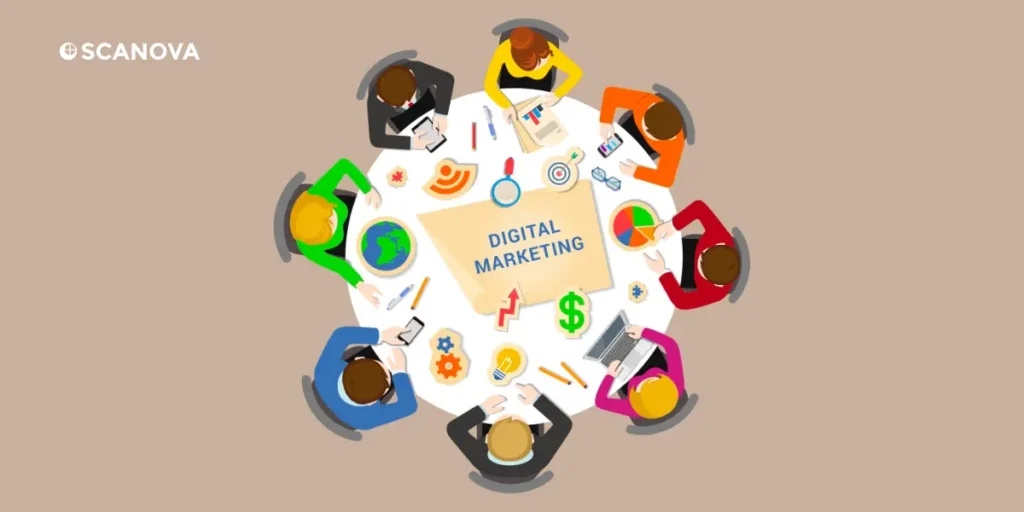Marketing campaigns aim to boost sales by drawing in new clients and, of course, keeping hold of current ones.
Moreover, in a more general sense, these campaigns are also important for promoting brands, goods, or services.
Social media promotion, email marketing, content marketing, and traditional advertising via print media are some of the various methods that campaigns can be carried out.
With so many channels at your disposal, each with advantages and disadvantages of their own, it’s critical to create a comprehensive plan that combines many techniques for the best results.
QR Codes, those pixelated squares, have found new life in the digital age, bridging the gap between traditional print media and the online world.
While they might seem like relics of the past, their strategic use can add dynamism and interaction to your marketing mix.
In a world dominated by screens, print media often struggles to capture attention. In this article, we will learn how a QR Code marketing strategy can revitalize your print marketing.
A. How to plan a successful QR Code marketing strategy

A successful QR Code marketing strategy can be a powerful way to engage customers, drive sales, and increase brand awareness.
However, achieving success requires careful planning, execution, and analysis. Here are the key steps to creating a successful QR Code marketing strategy:
Step 1: Define your objectives
Clearly define the goals of your QR Code marketing strategy. It could be to drive traffic to your website to increase sales, collect customer feedback, or promote a new product.
Understanding your objectives will guide the rest of your QR Code marketing strategy. After defining your end goal you can move to the next step of your QR Code marketing strategy.
Step 2: Identify your target audience
For the successful implementation of your QR Code marketing strategy, you should know who your target audience is and where they are likely to encounter your QR Codes.
Tailoring your messaging and designs to resonate with their interests and preferences will go a long way for your campaign.
Step 3: Create compelling content
If you want your campaign to actually bring results you need to develop engaging content that provides value to your audience.
This could include exclusive discounts, access to special content, product demonstrations, or interactive experiences.
Ensure that your content is relevant, informative, and easy to access via the QR Code.
Step 4: Design visually appealing QR Codes
You can design QR Codes that are visually appealing and aligned with your brand identity. You can customize QR Codes with colors, logos, and images to make them stand out and attract attention.
However, make sure the QR Code remains scannable by maintaining a high contrast between the code and the background.
Inculcating personalized QR Codes in your QR Code marketing strategy can create a visually appealing QR that will definitely attract more scans.
Generate a QR Code For Your Unique Case
START TODAY!
Step 5: Choose the right placement
Place your QR Codes in strategic locations where your target audience is likely to notice them.
This could include physical locations such as storefronts, product packaging, posters, flyers, or digital channels like social media, email campaigns, or websites.
Always remember that the primary intent of QR Codes is to make your tasks easier and more streamlined. Hence, placing them in locations that are difficult to access hinders their purpose.

Step 6: Provide clear instructions
Clearly communicate what users can expect when they scan the QR Code. Use concise instructions and call-to-action phrases to encourage scanning.
For example, “Scan to unlock exclusive offers” or “Scan for more information.”
Guiding your audience on what to do with a QR Code and what to expect from scanning it promotes inclusivity.
This serves the purpose of reaching as many people as you can through your QR Code marketing strategy.
Step 7: Test QR Code functionality
Before launching your campaign, thoroughly test your QR Codes to ensure they function properly on different devices and operating systems.
Testing the scanning process to verify that users are directed to the intended content without any issues is a must for a successful QR Code marketing strategy.
Step 8: Monitor and analyze performance
Track the performance of your QR Code marketing strategy using analytics tools. Analyze the data to identify trends, insights, and areas for improvement.
Monitor metrics such as scan rates, conversion rates, website traffic, and sales generated through QR Code scans.
Many online QR Code generators come with inbuilt QR Code analytics which can give you in-depth insight for your respective campaigns.
Step 9: Iterate and optimize
Based on your analysis, make adjustments to your QR Code marketing strategy to optimize performance.
This could involve refining your messaging, adjusting placement strategies, or experimenting with different types of content.
Continuously iterate and improve your campaign to maximize its effectiveness over time. You can even perform A/B Testing on campaigns and compare their results to analyze which QR Code performed better.
Step 10: Provide value and incentives
Offer incentives or rewards to users who scan your QR Codes to encourage participation and engagement.
This could include discounts, giveaways, exclusive content, or loyalty rewards. Providing value to users will increase the likelihood of them scanning your QR Codes and taking action.
As for your current customer base/ clients, rewards go a long way in making a connect with your audience and encouraging them to stick with your brand.
Generate a QR Code For Your Unique Case
START TODAY!
Cheers! That’s it! That’s all you need to do for a successful QR Code marketing strategy. Now let’s take a look at why a QR Code marketing strategy is important for your campaigns.
B. Why a QR Code marketing strategy is important

QR Codes represent a dynamic and versatile tool in modern marketing strategies, offering seamless integration across print and digital channels.
By strategically incorporating QR Codes into campaigns, marketers can enhance brand visibility, drive consumer engagement, and deliver compelling experiences to their audience.
Let’s take a look at the pivotal role of a QR Code marketing strategy:
1. Interactive content delivery
Successful integration of a QR Code marketing strategy enables print media to deliver interactive content seamlessly. Readers can simply scan the code with their smartphones to access additional information, multimedia content, exclusive offers, or interactive experiences related to the print material.
Many times while using print media you have limited space to display content and displaying more content comes with additional printing costs.
QR Code marketing strategy proves to be a cost-effective way to deliver content/information to the audience seamlessly.
This interactive layer enriches the reading experience, providing readers with more depth and engagement than traditional static content.
2. Enhanced engagement and call-to-action
Print media often struggles with measuring engagement and driving actions from readers. QR Codes address this challenge by providing a direct and measurable call-to-action.
If you are running a marketing campaign you would definitely want your audience to go to your websites or product pages or perform an action. In short, the ultimate goal is to turn your reach into sales effectively.
Whether it’s directing readers to a website, prompting them to sign up for a newsletter, or encouraging them to participate in a survey, QR Code marketing strategy facilitate immediate engagement and trackable responses.
3. Seamless Integration of offline and online marketing
A QR Code marketing strategy offers seamless integration between offline and online marketing efforts. Print advertisements, brochures, posters, and even product packaging can incorporate QR Codes to drive traffic to websites, social media pages, or online stores.
This integration strengthens brand visibility and enables marketers to track the effectiveness of their print campaigns by monitoring QR Code scans and subsequent online interactions.
4. Data collection and analytics
By using QR Codes, publishers and marketers can gather valuable data and insights about their audience’s behavior and preferences.
Through QR Code analytics, they can track metrics such as scan rates, geographical location of scans, time of scans, and user demographics.
This data provides invaluable feedback for optimizing future print campaigns and tailoring content to better resonate with the target audience.
5. Eco-friendly solutions
In an increasingly environmentally conscious world, QR Codes offer an eco-friendly alternative to traditional printed materials.
By reducing the need for extensive printed content, QR Codes contribute to paper and resource conservation.
Generate a QR Code For Your Unique Case
START TODAY!
Additionally, they enable dynamic and updatable content, reducing the environmental impact associated with reprinting outdated materials.
C. Practical applications of QR Codes in print media

Print media remains a cornerstone of marketing efforts, offering tangible experiences that resonate with consumers.
By integrating QR Codes into print materials such as posters, flyers, brochures, and product packaging, marketers can extend the reach and impact of their campaigns.
For example, a QR Code on a poster promoting a new product can direct interested consumers to a landing page with additional information, testimonials, and a call-to-action to make a purchase.
Similarly, a QR Code on a business card can link directly to a LinkedIn profile or personal website, facilitating seamless networking opportunities.
Let’s take a look at some of the most commonly used applications of QR Codes in print media that will enhance your QR Code marketing strategy:
1. Magazine and newspaper articles
Publishers can enhance articles with QR Codes linking to supplementary content such as videos, podcasts, or related articles.
QR Codes can also facilitate reader engagement by enabling instant feedback mechanisms or interactive quizzes thereby improving marketing efforts.
2. Advertising and marketing collateral
Advertisements, flyers, and promotional materials can leverage QR Codes to provide additional product information, discounts, or promotional offers.
QR Codes can also serve as entry points to social media campaigns or online contests, fostering deeper engagement with the brand.
3. Product packaging and labels
QR Codes on product packaging can offer consumers access to product manuals, usage tips, or customer support channels.
They can also be used for product authentication, allowing consumers to verify the authenticity of the product before purchase.
Brands like Decathlon and Puma have already started using QR Codes on their products to give customers information about product materials and to avoid counterfeit products.
4. Event promotion and ticketing
Event organizers can use QR Codes on posters, flyers, and tickets to provide event details, schedules, and ticket-purchasing options.
QR Codes can also streamline event check-in processes by enabling attendees to scan their tickets directly from their smartphones.
Generate a QR Code For Your Unique Case
START TODAY!
D. Amplifying digital campaigns through a QR Code marketing strategy

QR Codes aren’t limited to print. Here’s how they can add value to your digital marketing campaigns:
In digital marketing, QR Codes serve as valuable tools to bridge the gap between online and offline experiences.
In social media campaigns, QR Codes can be shared across platforms to encourage user engagement.
For instance, a brand might share a QR Code on Instagram that leads followers to a contest entry form or a special offer on their website.
Include QR Codes in your social media posts, directing users to product pages, discount codes, or behind-the-scenes content.
This encourages them to interact and learn more about your brand.
Moreover, QR Codes can enhance experiential marketing initiatives by providing interactive elements at events, trade shows, or pop-up activations.
Attendees can scan these QR Codes displayed on banners, signage, or product displays to access exclusive content, participate in surveys, or unlock discounts.
Integrating QR Codes into digital billboards or signage, allows for quick access to websites, contact information, or even app downloads.
This is a space-saving way to provide additional information without cluttering the visual elements.
E. Strategic implementation in email campaigns

While QR Codes excel in many marketing contexts, their effectiveness in email campaigns requires careful consideration.
Unlike other channels where users can easily scan QR Codes using their smartphones, email clients often do not support direct scanning within the interface.
This limitation can create friction in the user experience and hinder engagement. Including them in email campaigns is generally not recommended for a simple reason: Accessibility.
Most people access their emails on mobile devices, making it inconvenient and cumbersome to scan a QR Code using the same device.
This frustration can negatively impact the user experience and hinder engagement with your campaign.
However, QR Codes can still play a role in email marketing when strategically implemented.
Instead of embedding QR Codes directly into emails, marketers can leverage them in conjunction with landing pages or personalized URLs (PURLs).
Including a call-to-action in the email prompting recipients to scan a QR Code to access exclusive content or offers on a dedicated landing page can drive engagement and trackable interactions.
Generate a QR Code For Your Unique Case
START TODAY!
F. FAQs: QR Code Marketing Strategy

1. What is a QR Code?
A QR Code, short for Quick Response code, is a two-dimensional barcode that can store information such as text, URLs, or other data.
When scanned by a smartphone or QR Code reader, it directs the user to the encoded content.
2. How can QR Codes be used in marketing?
QR Codes can be used in marketing to provide easy access to digital content such as websites, promotions, coupons, product information, event details, social media profiles, and more.
They serve as a bridge between offline and online marketing channels.
3. What are the benefits of using a QR Code marketing strategy?
QR Codes offer several benefits including increased engagement, convenience for users, cost-effectiveness, trackability of interactions, versatility in usage across various marketing materials, and the ability to provide real-time analytics on user interactions.
4. How can I create QR Codes for my marketing materials?
You can use Scanova’s QR Code generator that allows you to create QR Codes for free. Simply input the desired content (URL, text, etc.), customize the design if needed, and download the generated QR Code for use in your marketing materials.
5. Where should QR Codes be placed for maximum effectiveness of a QR Code marketing strategy?
QR Codes should be placed in easily accessible locations where they are visible to your target audience.
Common placement locations include product packaging, posters, flyers, business cards, storefronts, menus, and digital screens.
6. How can I track the performance of my QR Code marketing strategy?
Many QR Code generators and marketing platforms offer analytics tools that track metrics such as scan rates, location data, time of scans, and devices used.
By analyzing these metrics, you can evaluate the effectiveness of your campaigns and make data-driven decisions for optimization.
7. Are there any best practices to follow when using QR Codes in marketing?
Yes, some best practices include ensuring that the content behind the QR Code is mobile-friendly, providing clear instructions on how to scan the code, testing the QR Code across different devices and environments, offering valuable incentives to encourage scanning, and regularly updating the linked content to keep it relevant.
8. What are some creative ways to incorporate QR Codes into marketing campaigns?
Creative uses of QR Codes include incorporating them into interactive treasure hunts or scavenger hunts, embedding them in artwork or murals, using them as virtual business cards, integrating them into product packaging for additional information or instructions, and leveraging them for contactless payments or ticketing.
9. Are there any security concerns associated with QR Code marketing?
While QR Codes themselves are generally secure, there are potential risks associated with malicious QR Codes that may lead users to phishing websites or malware.
To mitigate these risks, it’s important to educate users about scanning QR Codes from trusted sources and to regularly monitor and update linked content to prevent exploitation.
10. Can QR Codes be used for audience segmentation and personalized marketing?
Yes, QR Codes can be used to deliver personalized content or promotions based on factors such as location, demographics, or past interactions.
By dynamically generating QR Codes with unique identifiers, marketers can track individual user engagement and tailor subsequent interactions accordingly.
Conclusion
In conclusion, a successful QR Code marketing strategy requires careful planning, compelling content, strategic placement, clear instructions, thorough testing, and ongoing optimization.
By following these steps and continuously refining your approach based on data and feedback, you can create a campaign that effectively engages your target audience and achieves your marketing objectives.
Incorporating QR Codes into print media represents a symbiotic fusion of traditional and digital technologies, offering a myriad of benefits for publishers, marketers, businesses, and consumers alike.
By leveraging QR Codes, print media can evolve from static to interactive, from passive to engaging, and from isolated to interconnected.
Embracing this innovation not only revitalizes the relevance of print media in the digital age but also unlocks new avenues for creativity, engagement, and measurable impact.
As the boundary between offline and online continues to blur, QR Codes stand as a powerful tool for enriching the print experience and forging meaningful connections between the physical and digital worlds.
